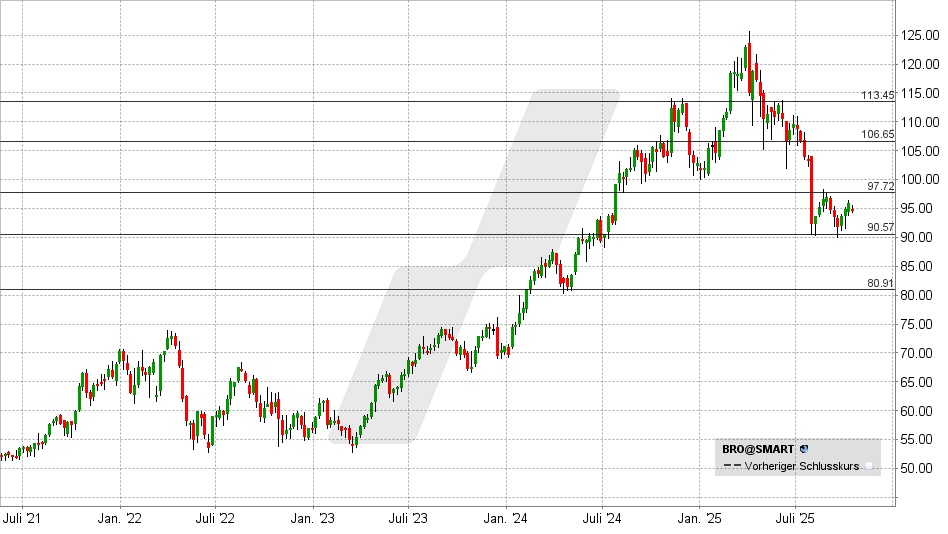Brown & Brown is a long-term outperformer and a dividend aristocrat. Reason enough to take a closer look at the company - all the more so as the share has recently been noticeably underperforming.
Three pillars in a fragmented market
Brown & Brown is one of the five largest insurance brokers in the USA.
The company operates in a stable, fragmented market with high barriers to entry. Brown & Brown's (BRO) market share is around 6 %, so there should be more than enough room for further growth.
The company acts exclusively as an intermediary between policyholders and insurance companies and does not bear any underwriting risk of its own.
BRO serves three central segments:
Retail Brokerage comprises direct sales to commercial and private customers in the so-called "Admitted Market". Standardized, state-regulated insurance policies are brokered here.
Wholesale Brokerage comprises trading in the "Excess & Specialty" market, in which special risks that are difficult to insure are placed. This area is higher-margin, as prices and contract terms are freely negotiable.
Finally, there is the Programs & Services segment, which comprises specialized insurance programs for specific industries or risk profiles.
Recurring crisis-proof income
BRO sells insurance policies on behalf of insurers, predominantly to small and medium-sized companies, and typically receives a commission of around ten percent on the annual insurance premiums due.
The business model is based on recurring, commission-based income. Many insurance policies - for example for liability, buildings, vehicles or employees - are required by law or are essential for operations.
This business model offers stability, scalability and high cash flow quality. Insurance premiums are generally paid even in times of crisis, which means that the business is easy to plan and comparatively crisis-proof.
Around three quarters of revenue is directly dependent on the level of insurance premiums, which means that Brown & Brown's business is effectively protected against inflation. Rising prices (inflation) lead to rising insurance premiums and therefore to higher income for BRO.
This factor almost "automatically" leads to organic growth at the level of inflation.
This makes Brown & Brown unique
All of this applies to direct competitors such as Marsh McLennan, Aon and Arthur J. Gallagheralso apply.
However, Brown & Brown is leaner and relies on a decentralized organizational structure. While large competitors are highly centralized, Brown & Brown's individual subsidiaries operate largely independently and with considerable entrepreneurial autonomy.
This structure promotes entrepreneurship, customer proximity and fast decision-making processes. It allows the company to retain local expertise while at the same time benefiting from the economies of scale of a national platform.
Another success factor is the consistent use of the strong free cash flow for acquisitions.
Brown & Brown regularly acquires smaller, profitable brokers with clear regional or sector-specific niches. These are integrated into the existing structure, which strengthens the negotiating position with insurers. As a rule, this significantly increases the profitability of the subsidiaries.
Enough fine words
With its focus on small and medium-sized corporate clients, Brown & Brown also differs from other industry giants, as they generally concentrate heavily on major clients.
In addition to fine words, Brown & Brown also offers solid figures. In the last ten years, turnover has almost tripled from USD 1.66 billion to USD 4.71 billion.
At the same time, profitability has improved somewhat. Most recently, the operating margin was 29%, so Brown & Brown could justifiably be described as highly profitable.
During this period, earnings climbed from USD 0.85 to USD 3.84 per share. Although Brown & Brown has made a number of acquisitions during this time, the number of shares outstanding has remained virtually unchanged. Aktien shares outstanding remained virtually unchanged and only rose from 276 to 282 million within a decade.
Outlook and valuation
The positive trend has continued consistently in the current financial year. In the last quarter, earnings of USD 1.03 per share were well above expectations of USD 0.98. With sales of USD 1.30 billion, analysts' estimates of USD 1.28 billion were also exceeded.
For the year as a whole, this corresponds to a 9.1 % increase in sales and a 10.8 % jump in profits.
This does not seem to be enough for investors at the moment. After the jump in profits in the two previous years, the current situation is being classified and labeled as "declining growth momentum".
Those who think in absolute terms will probably come to a different conclusion. Brown & Brown currently has a forward P/E of 22.7.
If profits rise by 13% in the coming year as expected, the P/E would fall to 20.
As Brown & Brown has enjoyed double-digit growth rates for a long time, the P/E has hovered around 25

Brown & Brown share: chart from 14.10.2025, price: USD 94.48 - symbol: BRO | source: TWS
An attempt to form a bottom is currently underway. If a breakout above USD 98 now succeeds, a procyclical uptrend will ensue. Kaufsignal with possible price targets at USD 100 and USD 105-106.66.
Above this, the path towards USD 113.50 would be clear.
If, on the other hand, the share falls below USD 90, the bulls will have lost their chance for the time being and price losses to USD 87.50 or USD 81 are to be expected
Source





